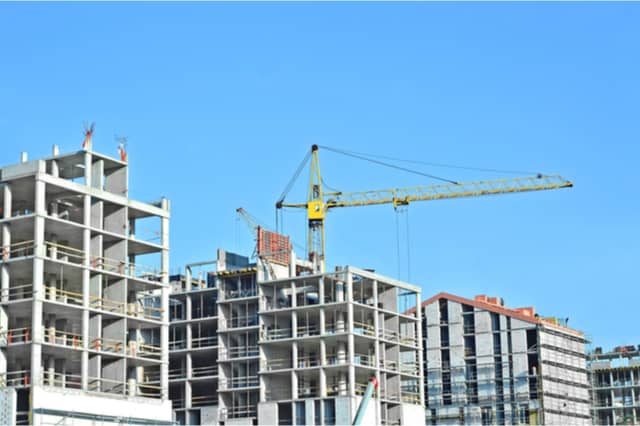
www.buildingsandcities.org/insights/commentaries/building-regulations-embodied-carbon.html
Why Building Regulations Must Incorporate Embodied Carbon

By Harpa Birgisdóttir (Aalborg University Copenhagen, DK)
Building regulations are important drivers for change. They have been focused on reducing the operational energy in buildings. This is now changing in some countries as evidence shows the significant amount of embodied emissions in construction materials. Additional new requirements are setting targets for embodied carbon in buildings and whole-life carbon assessments in order to decarbonise the built environment. Regulations are being implemented in Netherlands, France and Denmark, and planned in Finland and Sweden.
Globally, the building and construction sector is responsible for approximately 38% of all energy-related GHG emissions. Approximately 28% comes from operational energy use for the total existing building stock and another 10% comes from embodied carbon in materials for new construction and refurbishment (UNEP 2020). New annual construction only adds to a few percentage points of the existing building stock's total area. However, their share (and that of building refurbishments) of the embodied impacts related to construction of building materials is significant.
Energy requirements have been an essential and accepted part of building regulations in many countries for years. However, regulating energy and carbon in the operational aspect of buildings is not sufficient to create a net-zero society. Evidence from whole-life cycle carbon assessments of buildings shows increased importance of embodied carbon in building materials and components. In order to reduce the embodied carbon in materials, new requirements need to be introduced with limit values based on whole-life carbon assessments. We must start introducing requirements worldwide that also embrace the embodied carbon, as has already been implemented or agreed in the Netherlands, France and Denmark, and planned in Finland and Sweden (BPIE, 2021).
The hidden challenge of embodied impacts for new construction
Research has highlighted the increasing significance of embodied carbon in new construction. A systematic life cycle analysis of 650 buildings from around the world (that conform to current energy performance regulations in their respective countries) shows that the average share of embodied GHG emissions from buildings is approximately 20-25% of life cycle GHG emissions. This increases to 45-50% for highly energy-efficient buildings and surpasses 90% in extreme cases (Röck et al., 2020). A systematic study of the whole life carbon assessment of 60 building cases in Denmark found the share of embodied carbon is on average about 75% over a reference study period of 50 years. This finding is based on building regulation requirements for operational emissions and forecast lower emissions from the energy grid according to political agreements. In addition, this study shows a variation of the embodied carbon of up to 2.9 times, which indicate a large potential for reduction of both upfront and total carbon emissions of new constructions in Denmark (Zimmermann et al., 2021).
Introduction of carbon regulations in Denmark
In March 2021, the Danish government introduced targets in in the building regulations for whole life carbon which come into effect in 2023. This whole life approach embraces both operational and embodied carbon. Buildings below 1,000 m2 will initially only be required to calculate the life cycle assessment (LCA), while buildings over 1,000 m2 will be required to meet whole life carbon limits (CO2e). This applies for all building types. The initial limit value is 12 kg CO2e/m2/year, supported by a specific voluntary CO2-class with a limit value of 8 kg CO2/m2/year. The limit values are to be tightened every second year until 2029. The regulation of smaller buildings is expected to commence in 2025 (Ministry of the Interior and Housing, 2021).
Retrofitting the existing building stock
The retrofit of the existing building stock is needed in order to bring down the climate impacts of most buildings. Most assessments show the climate impacts of renovation is beneficial. However, this requires thought (and calculation) to ensure the embodied carbon in material choices does not ruin the gains in operational energy reductions (Kanafani et al., 2021).
Are these regulations meeting the Paris agreement?
These requirements are based on so called bottom-up benchmarks, which are based on a gradual reduction of the emissions compared to common building practice. But is this sufficient to meet the rapid decarbonisation that climate scientists say is needed to meet the goals agreed at the Paris COP? This issue has become even more urgent after the alarming climate reports from the IPCC (2021).
Can the construction sector deliver more? The assessment and calculation of the climate impact of buildings is a new discipline in construction, which the entire value chain is now acquiring knowledge about how they can deliver to this agenda. Thereafter, the entire value chain must help to ensure that reductions are achieved.
The Danish example of regulating whole-life carbon is a crucial step in the right direction. But much bigger steps have to be taken to ensure that compliance with the Paris Agreement in order to avoid the worst-case scenarios for temperature rises. Therefore, the use of more ambitious benchmarks based on the real carbon budgets to stay within the climate parameters set by the Paris Agreement, so called top-down based targets, have to come into play worldwide (Habert et al., 2020). For the Danish case, it is crucial that as many as possible fulfill the voluntary CO2 class with ambitious benchmarks.
There is no doubt about the difficult challenges facing the construction sector, but ambitious efforts can also contribute effectively to the necessary overall reduction of climate impacts. International cooperation and harmonization are key and need to be accelerated. The ongoing International Energy Agency Annex 72 "Assessing Life Cycle Related Environmental Impacts Caused by Buildings" is one important enabler (Frischknecht et al., 2019). Research plays an important role in the development of robust evaluation methods that include the timing of reductions and avoid greenwashing. Experiences, tools and methods from the countries that have taken the first steps should be implemented as soon as possible in countries taking their first steps.
References
BPIE. (2021). Whole-life carbon: challenges and solutions for highly efficient and climate-neutral buildings. Brussels: Buildings Performance Institute Europe. https://www.bpie.eu/wp-content/uploads/2021/05/BPIE_WLC_Summary-report_final.pdf
Frischknecht, R., Birgisdottir, H., Chae, C-U, Lützkendorf, T. and Passer, A. (2019). IEA EBC Annex 72 - Assessing life cycle related environmental impacts caused by buildings - targets and tasks. IOP Conference Series: Earth and Environmental Science, 323. SUSTAINABLE BUILT ENVIRONMENT D-A-CH CONFERENCE 2019 (SBE19 Graz) 11-14 September 2019, Graz, Austria.
Ministry of the Interior and Housing. (2021). National Strategy for Sustainable Construction Denmark. https://im.dk/Media/637602217765946554/National_Strategy_for_Sustainable_Construktion.pdf
Habert, G., Röck, M., Steininger, K., Lupisek, A., Birgisdottir, H., Desing, H., Chandrakumar, C., Pittau, F., Passer, A., Rovers, R., Slavkovic, K., Hollberg, A., Hoxha, E., Jusselme, T., Nault, E., Allacker, K. and Lützkendorf, T. (2020). Carbon budgets for buildings: harmonising temporal, spatial and sectoral dimensions. Buildings and Cities, 1(1), 429-452. http://doi.org/10.5334/bc.47
IPCC. (2021). Climate Change 2021: The Physical Science Basis. Contribution of Working Group I to the Sixth Assessment Report of the Intergovernmental Panel on Climate Change. [Masson-Delmotte, V., P. Zhai, A. Pirani, S.L. Connors, C. Péan, S. Berger, N. Caud, Y. Chen, L. Goldfarb, M.I. Gomis, M. Huang, K. Leitzell, E. Lonnoy, J.B.R. Matthews, T.K. Maycock, T. Waterfield, O. Yelekçi, R. Yu, and B. Zhou (eds.)]. Cambridge University Press. In Press.
Kanafani, K., Lund, A.M., Worm, A.S., Jensen, J.D., Birgisdottir, H., Rose, J. (2021). Klimaeffektiv renovering Balancen mellem energibesparelse og materialepåvirkninger i bygningsrenovering. BUILD Rapport No. 2021:24. https://build.dk/Pages/Klimaeffektiv-renovering.aspx
Röck, M., Saade, M.R., Balouktsi, M., Rasmussen, F.N. Birgisdottir, H., Frischknecht, R., Habert, G., Lützkendorf, T. & Passer, A. (2020). Embodied GHG emissions of buildings - the hidden challenge for effective climate change mitigation. Applied Energy, 258, 114107. https://doi.org/10.1016/j.apenergy.2019.114107
UNEP. (2020). 2020 Global Status Report for Buildings and Construction: Towards a Zero-emission, Efficient and Resilient Buildings and Construction Sector. Nairobi: United Nations Environment Programme. https://wedocs.unep.org/bitstream/handle/20.500.11822/34572/GSR_ES.pdf?sequence=3&isAllowed=y
Zimmermann, R. K., Andersen, C. M. E., Kanafani, K., & Birgisdottir, H. (2021). Whole Life Carbon Assessment of 60 buildings: Possibilities to develop benchmark values for LCA of buildings. Polyteknisk Boghandel og Forlag. BUILD Report No. 2021:12 https://sbi.dk/Pages/Whole-Life-Carbon-Assessment-of-60-buildings.aspx
Latest Peer-Reviewed Journal Content
Positive energy districts and energy communities: how living labs create value
E Malakhatka, O Shafqat, A Sandoff & L Thuvander
Built environment governance and professionalism: the end of laissez-faire (again)
S Foxell
Co-creating justice in housing energy transitions through energy living labs
D Ricci, C Leiwakabessy, S van Wieringen, P de Koning & T Konstantinou
HVAC characterisation of existing Canadian buildings for decarbonisation retrofit identification
J Adebisi & J J McArthur
Simulation and the building performance gap [editorial]
M Donn
Developing criteria for effective building-sector commitments in nationally determined contributions
P Graham, K McFarlane & M Taheri
Reimagining circularity: actions for optimising the use of existing buildings
R Lundgren, R Kyrö, S Toivonen & L Tähtinen
Effective interdisciplinary stakeholder engagement in net zero building design
S Vakeva-Baird, F Tahmasebi, JJ Williams & D Mumovic
Metrics for building component disassembly potential: a practical framework
H Järvelä, A Lehto, T Pirilä & M Kuittinen
The unfitness of dwellings: why spatial and conceptual boundaries matter
E Nisonen, D Milián Bernal & S Pelsmakers
Environmental variables and air quality: implications for planning and public health
H Itzhak-Ben-Shalom, T Saroglou, V Multanen, A Vanunu, A Karnieli, D Katoshevski, N Davidovitch & I A Meir
Exploring diverse drivers behind hybrid heating solutions
S Kilpeläinen, S Pelsmakers, R Castaño-Rosa & M-S Miettinen
Urban rooms and the expanded ecology of urban living labs
E Akbil & C Butterworth
Living with extreme heat: perceptions and experiences
L King & C Demski
A systemic decision-making model for energy retrofits
C Schünemann, M Dshemuchadse & S Scherbaum
Modelling site-specific outdoor temperature for buildings in urban environments
K Cebrat, J Narożny, M Baborska-Narożny & M Smektała
Understanding shading through home-use experience, measurement and modelling
M Baborska-Narożny, K Bandurski, & M Grudzińska
Building performance simulation for sensemaking in architectural pedagogy
M Bohm
Beyond the building: governance challenges in social housing retrofit
H Charles
Heat stress in social housing districts: tree cover–built form interaction
C Lopez-Ordoñez, E Garcia-Nevado, H Coch & M Morganti
An observational analysis of shade-related pedestrian activity
M Levenson, D Pearlmutter & O Aleksandrowicz
Learning to sail a building: a people-first approach to retrofit
B Bordass, R Pender, K Steele & A Graham
Market transformations: gas conversion as a blueprint for net zero retrofit
A Gillich
Resistance against zero-emission neighbourhood infrastructuring: key lessons from Norway
T Berker & R Woods
Megatrends and weak signals shaping future real estate
S Toivonen
A strategic niche management framework to scale deep energy retrofits
T H King & M Jemtrud
Generative AI: reconfiguring supervision and doctoral research
P Boyd & D Harding
Exploring interactions between shading and view using visual difference prediction
S Wasilewski & M Andersen
How urban green infrastructure contributes to carbon neutrality [briefing note]
R Hautamäki, L Kulmala, M Ariluoma & L Järvi
Implementing and operating net zero buildings in South Africa
R Terblanche, C May & J Steward
Quantifying inter-dwelling air exchanges during fan pressurisation tests
D Glew, F Thomas, D Miles-Shenton & J Parker
Western Asian and Northern African residential building stocks: archetype analysis
S Akin, A Eghbali, C Nwagwu & E Hertwich



Latest Commentaries
Building-Related Research: New Context, New Challenges
Raymond J. Cole (University of British Columbia) reflects on the key challenges raised in the 34 commissioned essays for Buildings & Cities 5th anniversary. Not only are key research issues identified, but the consequences of changing contexts for conducting research and tailoring its influence on society are highlighted as key areas of action.
Lessons from Disaster Recovery: Build Better Before
Mary C. Comerio (University of California, Berkeley) explains why disaster recovery must begin well before a disaster occurs. The goal is to reduce the potential for damage beforehand by making housing delivery (e.g. capabilities and the physical, technical and institutional infrastructures) both more resilient and more capable of building back after disasters.